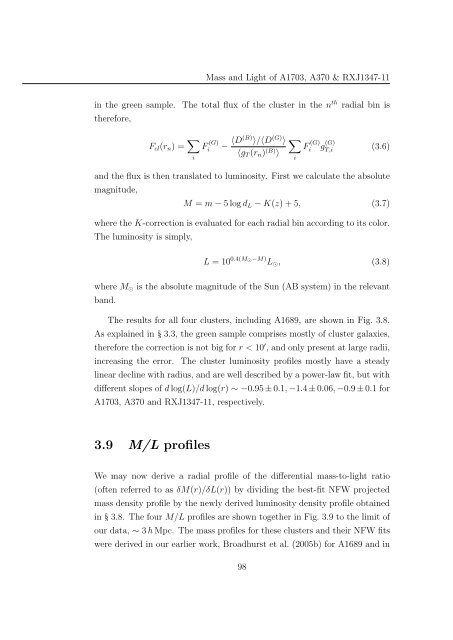Mass and Light distributions in Clusters of Galaxies - Henry A ...
Mass and Light distributions in Clusters of Galaxies - Henry A ...
Mass and Light distributions in Clusters of Galaxies - Henry A ...
Create successful ePaper yourself
Turn your PDF publications into a flip-book with our unique Google optimized e-Paper software.
<strong>Mass</strong> <strong>and</strong> <strong>Light</strong> <strong>of</strong> A1703, A370 & RXJ1347-11<br />
<strong>in</strong> the green sample. The total flux <strong>of</strong> the cluster <strong>in</strong> the n th radial b<strong>in</strong> is<br />
therefore,<br />
F cl (r n ) = ∑ i<br />
F (G)<br />
i − 〈D(B) 〉/〈D (G) 〉<br />
〈g T (r n ) (B) 〉<br />
∑<br />
i<br />
F (G)<br />
i g (G)<br />
T,i<br />
(3.6)<br />
<strong>and</strong> the flux is then translated to lum<strong>in</strong>osity. First we calculate the absolute<br />
magnitude,<br />
M = m − 5 log d L − K(z) + 5, (3.7)<br />
where the K-correction is evaluated for each radial b<strong>in</strong> accord<strong>in</strong>g to its color.<br />
The lum<strong>in</strong>osity is simply,<br />
L = 10 0.4(M ⊙−M) L ⊙ , (3.8)<br />
where M ⊙ is the absolute magnitude <strong>of</strong> the Sun (AB system) <strong>in</strong> the relevant<br />
b<strong>and</strong>.<br />
The results for all four clusters, <strong>in</strong>clud<strong>in</strong>g A1689, are shown <strong>in</strong> Fig. 3.8.<br />
As expla<strong>in</strong>ed <strong>in</strong> § 3.3, the green sample comprises mostly <strong>of</strong> cluster galaxies,<br />
therefore the correction is not big for r < 10 ′ , <strong>and</strong> only present at large radii,<br />
<strong>in</strong>creas<strong>in</strong>g the error. The cluster lum<strong>in</strong>osity pr<strong>of</strong>iles mostly have a steady<br />
l<strong>in</strong>ear decl<strong>in</strong>e with radius, <strong>and</strong> are well described by a power-law fit, but with<br />
different slopes <strong>of</strong> d log(L)/d log(r) ∼ −0.95 ± 0.1, −1.4 ± 0.06, −0.9 ± 0.1 for<br />
A1703, A370 <strong>and</strong> RXJ1347-11, respectively.<br />
3.9 M/L pr<strong>of</strong>iles<br />
We may now derive a radial pr<strong>of</strong>ile <strong>of</strong> the differential mass-to-light ratio<br />
(<strong>of</strong>ten referred to as δM(r)/δL(r)) by divid<strong>in</strong>g the best-fit NFW projected<br />
mass density pr<strong>of</strong>ile by the newly derived lum<strong>in</strong>osity density pr<strong>of</strong>ile obta<strong>in</strong>ed<br />
<strong>in</strong> § 3.8. The four M/L pr<strong>of</strong>iles are shown together <strong>in</strong> Fig. 3.9 to the limit <strong>of</strong><br />
our data, ∼ 3 h Mpc. The mass pr<strong>of</strong>iles for these clusters <strong>and</strong> their NFW fits<br />
were derived <strong>in</strong> our earlier work, Broadhurst et al. (2005b) for A1689 <strong>and</strong> <strong>in</strong><br />
98
















